Exploring the Mechanics of Sail Functionality
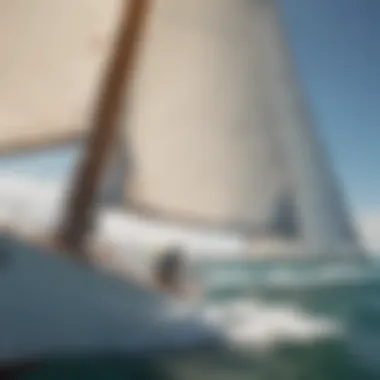
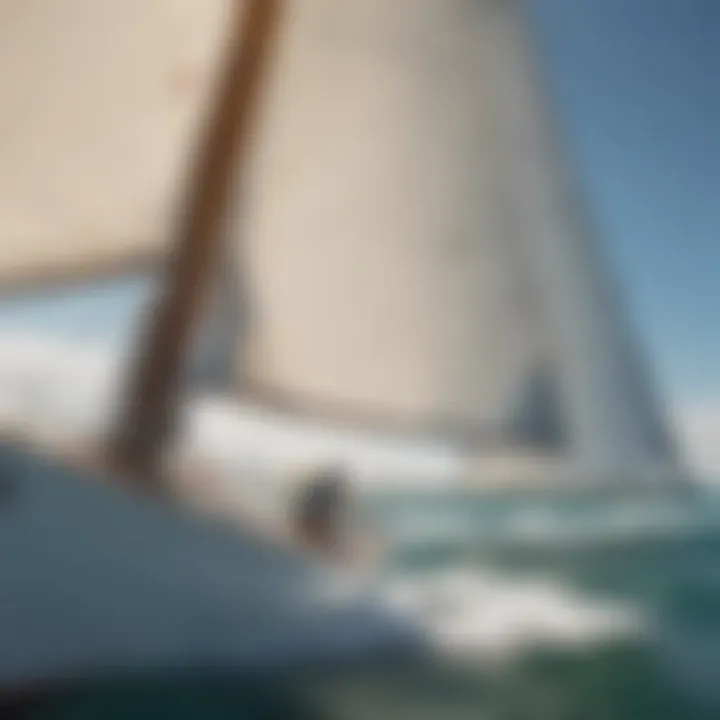
Intro
Sailing is often seen as an art more than a mere technique. A dance between wind, water, and vessel. To truly grasp how sails function requires an understanding that goes beyond the surface level. The very essence of sailing lies in the principles of aerodynamics, material science, and environmental conditions. It’s about harnessing the invisible forces of nature, the wind, and manipulating them to propel a boat forward.
When you think about it, sails are not just fabric they’re intricate structures designed to capture wind. This article explores the complexity behind sails, dissecting every aspect that contributes to their functionality. By doing so, we aim to equip both novices and seasoned sailors with a comprehensive guide that sheds light on all vital components. From the design of the sail to the impact of weather patterns, every element plays a crucial role in the success of a sailboat.
Techniques and Skills
Fundamental Techniques for Beginners
For those new to sailing, understanding the basic techniques is crucial. One of the first things to learn is how to rig a sail properly. A well-rigged sail will make maneuvering much simpler. Begin with the following techniques:
- Understanding Sail Shape: The shape affects how a sail interacts with the wind. A fuller sail generates more power but requires careful handling.
- Tuning the Rigging: Adjusting the tension of the lines is essential. Too loose, and the sail flaps; too tight, and you might lose speed.
- Sailing on Different Points: Knowing how to sail while heading into the wind, across the wind, and downwind is fundamental. Each point of sail has its own techniques and strategies.
Advanced Skills for Experienced Athletes
Once the foundational techniques are mastered, seasoned sailors can delve deeper into more advanced skills:
- Understanding Wind Patterns: This skill involves recognizing and predicting local wind behaviors. It can be the difference between an enjoyable day on the water and getting caught in dangerous gusts.
- Spinnaker Handling: Mastering a spinnaker is an art form in itself. This sail can dramatically increase speed but requires finesse in handling.
- Tactical Racing Strategies: For those looking to compete, understanding the nuances of race strategies, start line positioning, and current can help gain an edge.
Safety and Gear
Essential Safety Measures in Watersports
Safety should always be priority number one. In the world of sailing, where unpredictability can lurk around every corner, knowing safety measures is non-negotiable. Here are key measures to keep in mind:
- Life Jackets: Always wear a U.S. Coast Guard-approved floatation device. It’s your best friend in a pinch.
- Weather Monitoring: Before heading out, check the forecast. Sudden changes in weather can turn a pleasant outing into chaos.
- Communication Devices: Carry a VHF radio or a mobile phone in a waterproof case. Stay connected, and don’t hesitate to call for help when needed.
Gear Reviews and Recommendations
Choosing the right gear can make all the difference in your sailing experience. Some gear recommendations include:
- Sails: Brands like North Sails and Quantum Sails offer a plethora of options tailored to different sailing styles.
- Safety Equipment: Invest in high-quality safety gear from companies such as Spinlock. Their harnesses and flotation devices are top-notch.
- Navigation Tools: A reliable GPS unit is vital. Garmin and Raymarine offer great products suited for both leisure and competitive sailing.
"Understanding your sail is like knowing the pages of a book; it unlocks the adventures waiting on the water."
The dynamics of sail functionality are far-reaching and layered with complexity. By digging into the techniques, skills, and safety gear, one can navigate the world of sailing with confidence and ease. Unpacking these elements not only enhances performance but also enriches the overall experience of being out on the water.
Prolusion to Sail Mechanics
Sail mechanics serve as the backbone of any discussion surrounding sailing. Understanding how sails function is critical for both seasoned sailors and those just dipping their toes into the world of wind-powered vessels. By grasping the core concepts of sail mechanics, individuals can appreciate the intricate dance between wind, water, and the vessel itself. The unique interplay of these factors determines not just the speed but also the safety and efficiency of a sailing journey.
Understanding the basics of sail mechanics brings several benefits. Firstly, it enhances navigational skills, allowing sailors to make informed decisions when adjusting sails based on wind conditions or other environmental factors. Secondly, it provides insight into the maintenance and selection of sails themselves, ensuring that sailors can choose the best materials and designs that suit their unique sailing needs or styles. Finally, mastering sail mechanics can lead to a more fulfilling experience on the water, as sailors develop a greater connection with their environment.
In essence, this section sets the stage for a comprehensive exploration of sailing by breaking down historical, practical, and scientific elements. Each of these factors contributes to the entire sailing experience, making an understanding of sail mechanics not just useful, but essential.
Historical Context of Sailing
Sailing is more than just a hobby; it's a practice steeped in history. The earliest sailboats date back thousands of years, perhaps even to ancient Egypt, where the Nile River served as both a highway and a lifeline for commerce and transportation. The evolution of sail technology has been shaped by culture, geography, and advancing maritime knowledge. In places like the Mediterranean, reliance on sails allowed civilizations to expand trade routes, creating an interconnected world long before modern transportation.
When we talk about the historical context of sailing, we see significant innovations. For instance, the lateen sail, with its triangular shape, introduced around the Middle Ages, marked a major advancement in sailing capability. This changed the game; it allowed sailors to catch wind from different angles, enhancing maneuverability and control over the vessel. Thus, the past continues to influence present-day sailing practices, providing a foundational understanding required to navigate today's waters.
Purpose and Importance of Sails
At the heart of sailing lies the sail itself. The primary purpose of a sail is simple yet profound: to capture wind and convert it into forward motion. This action, while seemingly straightforward, involves a mastery of principles that dictate how a sail operates in various conditions.
There are multiple reasons why sails hold importance in sailing. Firstly, they are essential for propulsion. Unlike motorized boats that rely on fuel, sails use wind, making them a sustainable choice. This inherent connection to nature not only brings joy to those who sail but also aligns with environmental considerations that are increasingly significant in today's world.


Furthermore, sails play a crucial role in providing stability and balance to the vessel. Well-designed sails can help sailors maintain control, especially in changing weather conditions. The intricate shapes and materials used in sail design allow for the manipulation of airflow, ultimately enabling sailors to harness the full potential of the wind.
"Understanding the dynamic nature of sails allows sailors to read the wind like a book, guiding their journey with finesse and precision."
Fundamental Principles of Aerodynamics
Understanding the principles of aerodynamics is like knowing the secret handshake in a club reserved for sailors. This knowledge enables enthusiasts to harness the wind's power efficiently, maximizing their sailing experience. The fundamental principles lay down the foundation for how and why sails perform the way they do, providing insights that can dramatically impact a sailor's success on the water.
Understanding Wind Dynamics
Wind is more than just moving air; it’s the lifeblood of sailing. To grasp wind dynamics, one must start by acknowledging that wind behaves like a river. It flows and fluctuates, influenced by various factors such as topography and atmospheric pressure differential.
In open waters, the wind often encounters obstacles—like islands or buoys—that can create variable effects.
- Clean Air vs. Turbulent Air: When the wind blows unobstructed, it offers a clean flow that allows sails to catch the air efficiently. However, once it interacts with obstacles, turbulence is created, leading to a less predictable sailing environment.
- Local Winds: Every sailboat navigator should understand local wind patterns. For instance, a sunny day can lead to thermal breezes, especially on large bodies of water, as the heat creates upward drafts that pull in cooler air from surrounding areas.
These dynamics shape how sails operate—knowing when to expect shifts can significantly enhance performance.
Lift Generation Mechanism
At the heart of sailing lies the capability to generate lift, a concept that hails from aviation but is crucial for marine navigation as well. Lift is produced when the wind moves over and under the sail, creating a pressure difference that propels the craft forward.
- Bernoulli’s Principle: This principle states that an increase in the speed of the fluid results in a decrease in pressure. For sails, when wind flows faster over the curved surface, it creates lower pressure above the sail and higher pressure below. This differential generates lift, pushing the sail, and ultimately the boat, forward.
- Angle of Attack: Adjusting the sail’s angle relative to the wind stream is vital. Too steep an angle might cause drag, while too shallow a one might not generate enough lift. Finding that sweet spot is where mastery comes into play.
It's the delicate dance of physics that enables sailors to move swiftly and decisively across the waves.
Drag Forces in Sailing
While lift is essential, one must also reckon with drag—the enemy of speed. Drag works against the force of lift and comes in two forms: skin friction and form drag.
- Skin Friction: This arises when wind adheres to the surface of the sail and the hull, creating a frictional force that slows the boat.
- Form Drag: This type of drag occurs due to the shape of the sail and the hull disrupting the airflow.
Sailors need to strike a balance between lift and drag to optimize performance. Tuning the sails to reduce drag can lead to a smoother sail and better handling. Furthermore, understanding the drag forces can help sailors make quick decisions on whether to trim a sail or adjust course.
"In sailing, knowing how to dance with the wind—understanding lift, drag, and the dynamics of wind—is what sets the adept apart from the mere dabblers."
By internalizing these fundamental principles, sailors can make informed decisions on how to optimize sail functionality for efficiency, speed, and ultimately, enjoyment. Understanding the interplay of wind dynamics, lift mechanisms, and drag forces is not merely academic; it’s the key to unlocking seamless sailing experiences.
Components of a Sail
The design and functionality of sails hinge on their various components, each playing a significant role in how a vessel interacts with wind and water. Understanding the components of a sail is crucial for optimizing performance on the sea, whether you're a seasoned sailor or a novice eager to learn the ropes. In essence, sails are not mere fabric; they are engineered entities that come together to harness natural forces for propulsion. Here are the key elements worth exploring.
The Sailcloth Material
The choice of sailcloth material is paramount. Traditionally, cotton was the go-to fabric due to its availability and ease of handling. However, modern advancements have introduced synthetic options such as polyester and mylar, which offer durability and better performance. The correct material will possess a balance of lightweight properties, UV resistance, and strength to endure the harsh marine environment.
- Benefits of Synthetic Materials:
- Considerations:
- Increased durability which translates to a longer lifespan.
- Better resistance to mold and rot compared to natural fibers.
- Enhanced performance across various wind conditions.
- The choice between heavier or lighter cloth can influence responsiveness in varying wind conditions.
- Costs can vary significantly between types of materials, thus requiring a careful budget assessment.
Sail Shape and Design
When it comes to sails, the shape and design are what truly bring them to life. A well-designed sail will catch the wind efficiently, converting it into forward motion. The curvature, known as the camber, affects both lift and drag influences.
- Key Design Elements:
- Benefits of Optimal Design:
- Aspect Ratio: High-aspect sails (taller and narrower) generate less drag, while low-aspect sails (wider base) are more stable but less efficient.
- Headboard and Foot: The top and bottom of the sail can integrate into the overall design to maximize surface area.
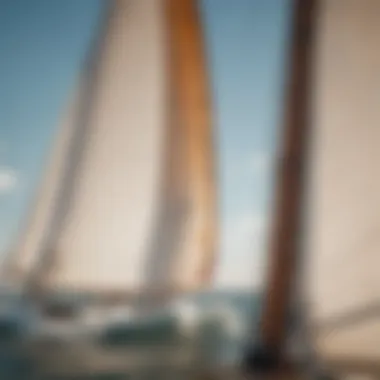
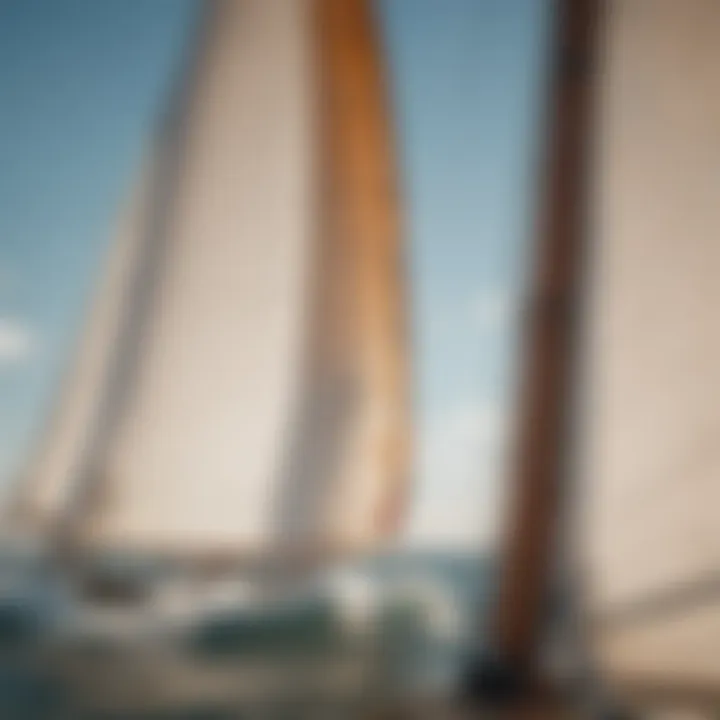
- Improves maneuverability and speed for competitive sailing.
- Customized shapes can enhance performance based on the intended sailing environment.
Rigging and Supporting Structures
No sail operates in a vacuum; it requires a robust system of rigging and supporting structures to function optimally. The rigging serves to hold the sail in place while allowing for adjustments as wind conditions change. This includes shrouds, stays, and halyards that work together to provide shape and tension to the sail.
- Types of Rigging:
- Importance of Good Rigging:
- Standing Rigging: This includes the cables that support the mast vertically and laterally.
- Running Rigging: These are the movable lines that sailors use to adjust the tension and angle of the sails.
- Ensures that sails can be adjusted quickly to adapt to wind changes.
- A well-rigged sail allows for smoother navigation and enhances overall sailing safety.
Important Note: The interplay between sailcloth material, sail design, and rigging is tantamount to ensuring that a vessel can respond to varying wind conditions efficiently. Each component must complement others to deliver an effective sailing experience.
In summary, a solid grasp on the components of a sail not only informs better sailing practices but also informs future choices regarding sail specs, ultimately impacting both performance and enjoyment on the water.
Sailing Techniques and Strategies
Sailing is not just about having a vessel and setting it adrift; it’s a dance of knowledge and skills that transforms the gusting winds into a seamless journey upon the water. The topic of sailing techniques and strategies is crucial in this article because it unpacks the practical knowledge necessary for any sailor eager to harness the wind effectively. Mastering these techniques can elevate a sailor’s performance, enhance safety, and ensure a rewarding sailing experience regardless of conditions.
Points of Sail
The term "points of sail" refers to the direction a sailboat is headed relative to the wind. Understanding this can make a significant difference in speed and maneuverability. When you think about sailing, it's akin to being a musician, where each point of sail is like a note on a scale. There are different points, such as close-hauled, beam reach, and running, which dictate how sails should be trimmed and how the boat reacts to wind.
- Close-Hauled: This position is when the sailboat sails as directly into the wind as possible, typically at an angle of 30 to 45 degrees. It’s where boats are most efficient in harnessing wind energy, though it also requires steady hands and keen balance.
- Beam Reach: This position occurs when the boat sails at a right angle to the wind. This is usually the fastest point of sail, which can feel exhilarating as the boat picks up speed.
- Running: In this position, the boat sails away from the wind. While this method may seem easy, controlling the sails to prevent accidental jibes requires skill.
Understanding how to navigate these various points can empower sailors to adapt and optimize their course accordingly, significantly improving their sailing efficiency.
Trim Adjustments
Trim adjustments refer to the way a sailor modifies sail shape and position to suit current wind conditions optimally. Proper trimming can mean the difference between a smooth sail and a frustrating battle against the elements. At its essence, trimming is all about letting the wind fill the sails just right. Most sailors will tell you that when everything is rightly trimmed, it's like an orchestra playing—everything comes together in perfect harmony.
Adjusting sails involves a few key elements:
- Angle of Attack: This relates to how the sail meets the oncoming wind. A well-altered angle will drastically impact the lift and drag forces at play.
- Sail Shape: The shape of the sail should change based on wind speed. For instance, in lighter winds, the sails may need to be fuller to capture more air, whereas in strong winds, flattening the sails can reduce heeling, or excessive leaning of the boat.
- Use of Sail Controls: Proper use of halyards, sheets, and outhauls can significantly lead to better trim adjustments. The subtleties matter—small tweaks can repay a sailor with much better performance.
Tacking and Gybing
Both tacking and gybing are essential maneuvers that allow sailors to change direction and harness wind from different angles. Understanding these actions is imperative to navigate effectively and maintain speed despite direction changes.
- Tacking: This maneuver involves turning the bow of the boat through the wind. The transition is key; it requires precision to ensure that the sails capture the wind on the opposite side effectively. Many novice sailors may struggle with timing, yet understanding this maneuver better can enhance both speed and control.
- Gybing: This is the act of turning the stern of the boat through the wind. It is often less challenging than tacking, but it poses its own risks, especially if the winds are gusty. A sailor must manage the boom effectively to avoid accidents. Proper techniques can help ease the transition and ensure a balance between speed and safety.
"Mastering the art of tacking and gybing isn't just a skill; it's a rite of passage for any sailor looking to command the waters."
Environmental Effects on Sailing
Sailing is as much a dance with nature as it is about the vessel itself. For sailors, understanding the environmental effects on sailing is not merely an academic curiosity; it’s essential for effective navigation and safe operation at sea. Wind, water currents, and weather all interact to create a tapestry of conditions that define the performance of a sailboat. Knowledge in this area equips sailors with the tools to make informed decisions, maximizing efficiency while ensuring safety.
Influence of Wind Conditions
Wind is the lifeblood of sailing. It’s the unseen force that propels vessels forward. However, winds are fickle and can change in strength and direction. Understanding these fluctuations is vital. For instance, a sailor might encounter fluky winds that shift unpredictably, making it crucial to adjust sails quickly or risk losing momentum.
Along with the strength of the wind, its direction plays a significant role. The effective angle at which wind hits the sail can vastly influence lift and drag, two elements pivotal to sailing. Here are some key points to consider:
- Wind Speed: Higher winds may require reefing the sails to maintain control, while lighter winds can mean an increase in sail area for better performance.
- Wind Direction: Awareness of how wind shifts impact the boat's direction and speed is crucial. Tuning in to local wind patterns, often influenced by geographical features, can lead to more favorable conditions.
Effective sailors are constantly reading the wind, as it is a skill that can be honed over time.
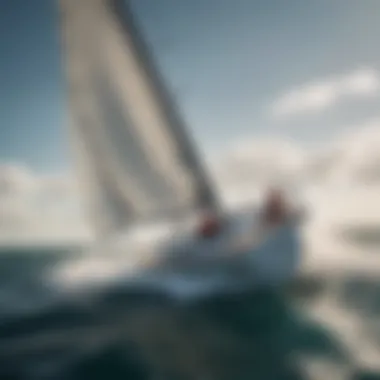
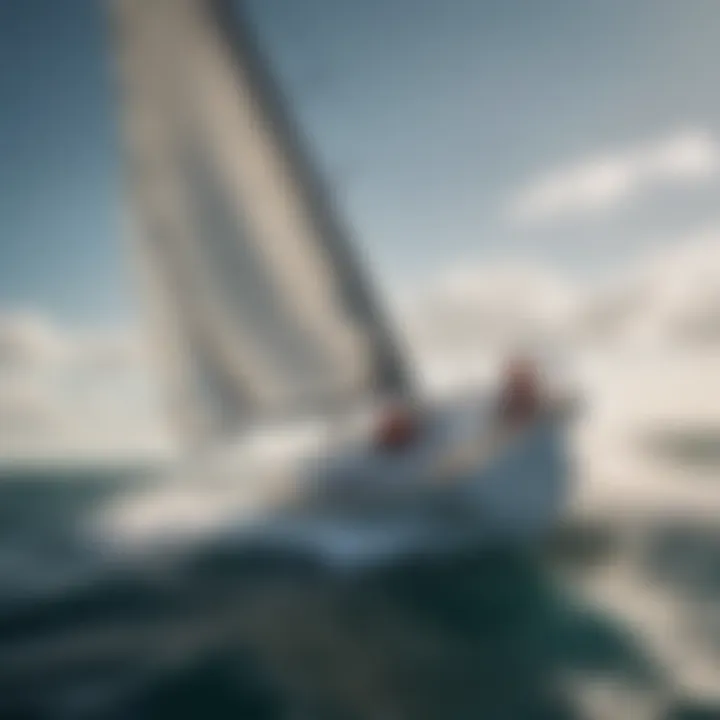
Impact of Current and Tides
The relationship between sailing and water currents is often underestimated. Tides and currents are as complex as the wind and can dramatically alter a boat's trajectory and speed. An understanding of these forces can make or break a journey.
- Currents: Strong currents can push a sailboat off course if not accounted for properly. In coastal areas, knowledge of the local current patterns will give sailors an edge, aiding in navigation and strategic planning.
- Tides: Sailors must be fully aware of the timing and height of the tides to avoid getting stuck in shallow areas or missing dock openings. Calculating tide schedules and their impact on planned routes is fundamental.
Weather Considerations
Weather is a critical factor that every sailor needs to grasp. From storms that can appear out of nowhere to serene days that lull one into complacency, being responsive to weather changes is vital
- Storms and Fronts: Learning to recognize early signs of a storm can protect both boat and crew. Advanced preparation might include changing sail configurations or finding safe harbor.
- Temperature and Humidity: Changes in temperature and humidity can influence wind behavior. For example, warm air rising can create thermal winds that offer additional speed but also come with unpredictability.
Understanding the weather as a sailor enhances not just safety but also enjoyment while at sea. The rhythms of wind, water movement, and atmospheric conditions create a unique sailing experience.
In summary, environmental effects are fundamental when it comes to sail functionality. Both novice and seasoned sailors should embrace the ever-changing dynamics of nature, turning them into advantages rather than obstacles.
Innovations in Sail Technology
Sail technology plays a crucial role in enhancing the performance and efficiency of sailing vessels. This section focuses on the latest advancements that are reshaping how sails operate and interact with the elements. The adoption of cutting-edge materials, innovative design strategies, and the integration of digital tools are not merely trends; they mark a substantial leap towards more sustainable and high-performing sailing practices. These innovations are essential for both competitive sailors aiming for the fastest times and leisure sailors seeking a more enjoyable experience.
Advancements in Materials
The evolution of sail materials has significantly impacted sail functionality. Traditional cotton and flax fibers have given way to synthetic alternatives like Mylar, Dacron, and Kevlar. These materials offer superior durability and lighter weight, leading to sails that can withstand the rigors of harsh conditions without compromising performance. For instance, using Mylar allows for lower stretch, which means the sail retains its shape better, providing more consistent lift.
Another fascinating development is the introduction of sail fabrics that incorporate nanotechnology. These high-tech fabrics can repel water, reduce friction, and even harness solar energy to power onboard systems. The use of composite materials, such as carbon fiber for race sails, has also gained traction. Such strategic choices reflect a shift towards materials that not only enhance performance but also support sustainability efforts in sailing by using recyclable sources wherever possible.
Design Improvements
Design in sail technology has come a long way from the traditional triangular shapes. Thanks to computer modeling and advanced simulation tools, designers can create more efficient sail shapes through iterative testing. The use of special software allows designers to predict how a sail performs under different wind conditions, leading to more optimized forms that maximize lift while minimizing drag.
Recent designs such as wing sails have garnered interest for their unique benefits. Unlike conventional triangular sails, wing sails mimic the shape of an airplane wing, generating lift more effectively. This alteration can lead to substantial gains in speed and energy efficiency. Additionally, the adjustable nature of these sails allows sailors to fine-tune them on the fly, adapting to fluctuating wind conditions.
"Innovative sail designs, such as the wing sail, have revolutionized the dynamics of wind interaction in sailing, offering unprecedented advantages in speed and versatility."
Integrating Digital Tools
The digital age has transformed many aspects of sailing, and sail technology is no exception. The integration of digital tools such as sail performance analysis software and weather forecasting apps leads to smarter sailing practices. These tools facilitate real-time data collection, allowing sailors to assess sail trim adjustments based on prevailing wind patterns.
Moreover, advancements in computer-aided design have enabled a tailored approach to sail creation. Sailors can input specific metrics and sailing styles to receive customized sail designs that reflect their unique preferences and needs. Drones equipped with sensors can assist in capturing wind conditions around the vessel, feeding valuable information that further optimizes sail settings.
Sensors embedded in sails can provide instant feedback on performance analytics, making it easier for sailors to understand how their sails interact with the wind, resulting in improved tactics during races or leisurely sails.
In summary, the world of sail technology is brimming with innovations that enhance the ways we harness wind. These advancements collectively work not just to boost sailing efficiency but also to drive the sailing community towards more eco-friendly practices. As materials improve and designs become more adept at utilizing wind dynamics, the horizons for sailing enthusiasts will only expand.
End: The Future of Sailing
As we navigate through the currents of change, understanding the future of sailing is paramount for enthusiasts and professionals alike. The evolution of sailing doesn’t merely rest on advancements in technology but also hinges on a collective consciousness about how we interact with our environment. This dual focus on innovation and sustainability is what will propel the sailing community into a more responsible and fulfilling future.
Sustainability in Sailing Practices
Sustainability isn't just a buzzword—it's becoming a standard practice for sailing enthusiasts around the globe. With the looming threats of climate change, sailors are increasingly aware of their environmental responsibilities. One crucial element is the selection of materials used in sail manufacturing. Many manufacturers are investing in eco-friendly options. For instance, sails made from recycled polyester can cut down on the demand for virgin resources, and companies like North Sails are leading the charge with innovative fabrics.
In addition to materials, the practices on the water must shift as well. Sailors are beginning to embrace principles from waste reduction to energy conservation. Minimizing fuel usage during long-haul trips by maximizing sail power is one practical way to ensure that the beauty of the waters remains intact. Moreover, education plays a significant role in this transition, as more courses integrate sustainability into their curricula, teaching new sailors the importance of preserving sea ecosystems.
A shift towards sustainable sailing not only benefits the environment but also enhances the experience on the water, making trips more meaningful and connected to nature.
The Evolution of Sailing Culture
The sailing culture is transforming, reflecting broader societal changes. Historically seen as a luxurious pastime, sailing is increasingly becoming an inclusive activity. Community sailing programs and initiatives are encouraging participation from diverse demographics, proving that sailing can be accessible to anyone willing to learn.
Moreover, technology has shifted this culture dramatically. Digital tools not only aid navigation but offer opportunities for shared experiences through social platforms. For example, online forums such as Reddit enable sailors to exchange tips, navigate challenges, and celebrate victories together, thus creating a vibrant online community.
As we look ahead, the culture around sailing is merging traditional skills with modern technology, creating a unique blend of heritage and innovation. Sailing events are adapting too, embracing global competitions that unite sailors from different backgrounds, celebrating cross-cultural exchanges. This evolution makes sailing more than just a mode of travel—it is becoming a shared journey rooted in community, sustainability, and a deep respect for our oceans.
In summary, the future of sailing lies in its ability to adapt and innovate while remaining cognizant of environmental responsibilities. With every sail raised, we remind ourselves of our past while charting a course for a sustainable path forward.















